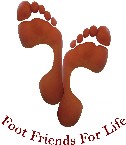Football Injuries
SERVICES > Injuries
Football Injuries
Preventative measures and treatment for football-related foot and leg conditions involve strengthening exercises to bolster support in the feet and ankles, advice on appropriate footwear specific to the participant’s chosen sport and orthotic devices for added stability. Ongoing foot care for the prevention and management of wear and tear injuries such as blisters, corns and calluses, along with fungal infections such as Athlete’s Foot — common among athletes at all levels — are important for healthy feet among leisure, amateur and professional sportspeople. Follow the steps below to keep feet healthy and on the playing field.
Warm-up
Always warm-up thoroughly before getting out on the field. A good warm-up is crucial to injury prevention and muscles and joints should be acclimatised to the level of exercise to come through light aerobic activity and stretching exercises.
Fitness
Injuries most commonly occur when the athlete is tired and the muscles and ligaments are no longer working as hard as they should be to stabilise the joints and maintain balance. Football, along with soccer and rugby, involves frequent periods of sprinting, followed by walking and rest periods. Training should always replicate the type of activity required in the field so that participants are ‘match fit’.
Strength Training
The use of resistance weights is effective in building up the muscle required to support joints, in particular around the knee and ankle joints. Resistance training has been shown to be especially beneficial in the prevention of ACL injuries.
Shoes
The right equipment can mean the difference between a great game and sit injured on the bench. It’s important to always wear the correct shoes for the sport and the surface you are playing on and specialist advice should be sought when purchasing football boots. Different types of boots are better suited to a dry or wet pitch, for example. Your podiatrist can evaluate a player’s boots to check that they are suitable and can offer advice on changes that may make the world of difference to any pain or discomfort a player is experiencing.
Orthotics
Beyond the choice of sport-appropriate footwear, orthotics can provide extra support when you need it most. Orthotics are inserts that are placed inside your football boots to adjust imbalances and the movement of your feet, which is often altered through compensating for other injuries or biomechanical problems. Customised sports orthotics help alter the ground reaction force experienced by the feet during running to improve walking and running efficiency.
Braces and Padding
Sports braces are designed to protect and stabilise the joint. Football players often wear these braces around the ankle or knee joints, and they are especially important if a player has had a prior injury to the joint. Some players wear shin pads to protect against injury to the lower legs, and compression padding in the form of specially designed shorts are becoming increasingly popular to keep muscles warm.
Cool Down
A proper cool down is just as important to injury prevention as a warm-up before a game. Stretching after the game lowers long-term risk of muscle tightening and also reduces muscular pain in the days after a match.
Running Injuries
There are a number of things that people can do to help prevent and treat running- related foot and leg problems. Strengthening exercises to build support in the feet and ankles, advice on the best footwear for each sport or physical activity, and using orthotics can all make a difference. Foot care is also important for stopping or managing wear-and-tear injuries like blisters, corns and calluses, along with fungal infections such as Athlete’s foot – a common problem for athletes at all levels. Follow the steps below to keep feet healthy and ready for the next race.
Warm-up
Always warm-up thoroughly before a run. A good warm-up is crucial to injury prevention and muscles and joints should be acclimatised to the level of exercise to come through light aerobic activity and stretching exercises.
Fitness
Strength Training
Shoes
Orthotics
Braces and Padding
Cool Down
